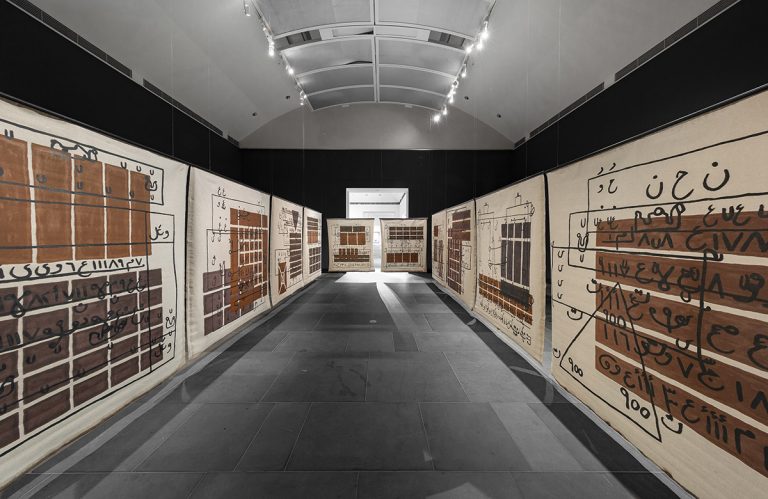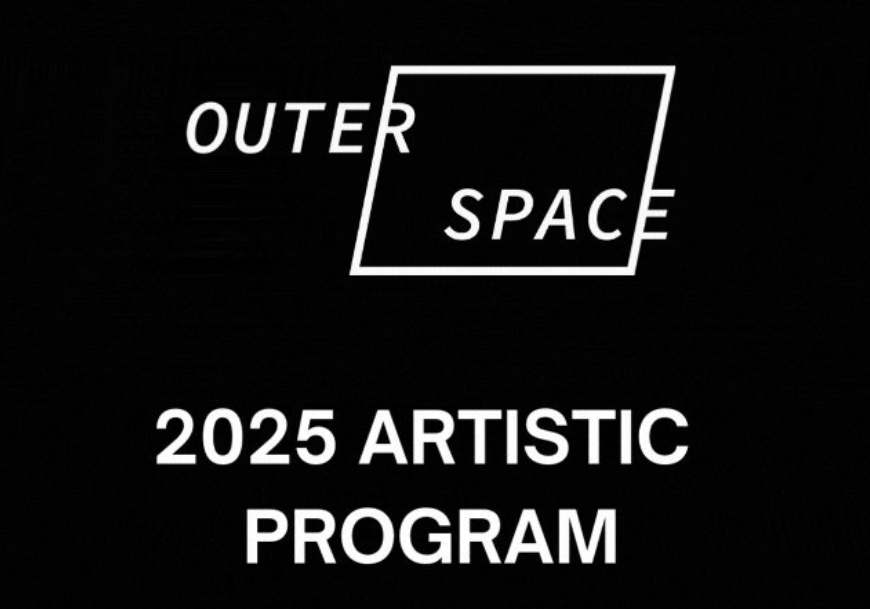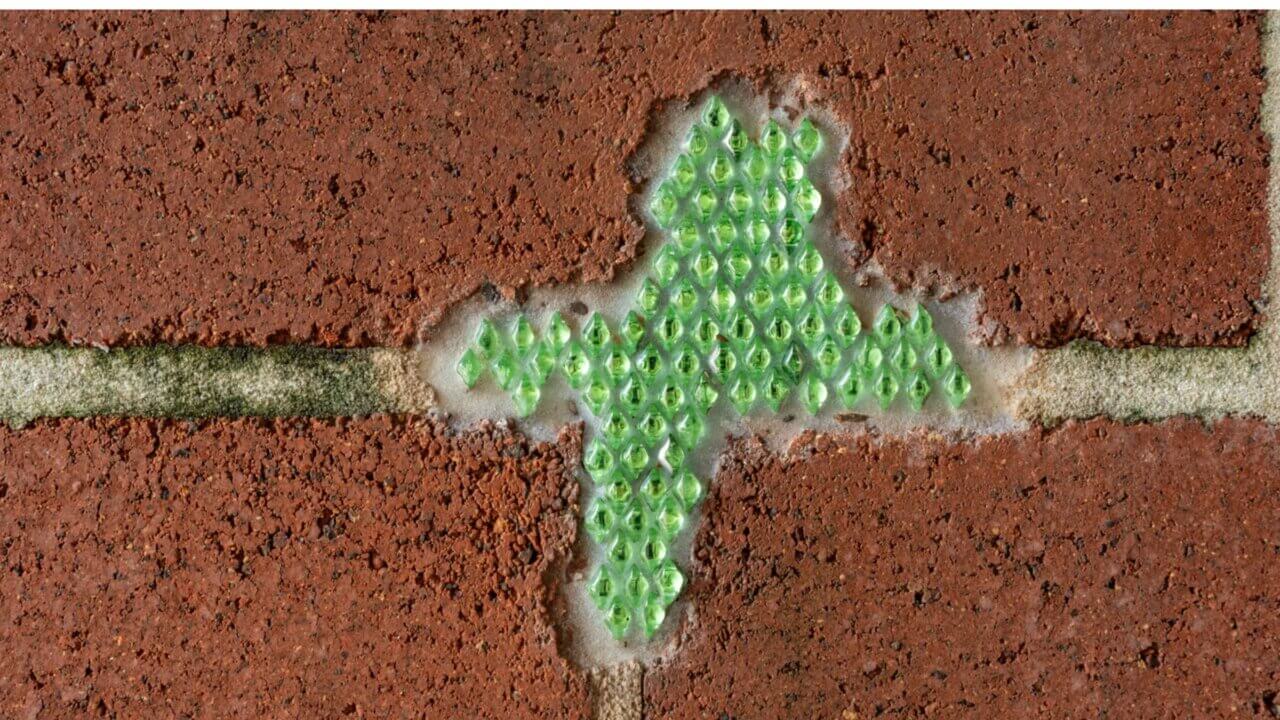
Helga Groves’ solo exhibition Tremor of Form, held at Woolloongabba’s Milani Gallery, consists of artworks which represent geological or cosmic objects whose timelines verge on the incomprehensible. These include minerals and stones which form underground over thousands, if not millions, of years, or meteorites whose genesis, trajectory, crash landing, and human rediscovery cover similarly immense temporal distances. Such natural items and developments belie a quantifiable classification, for dates and numbers do not adequately represent their vast timelines.
Formally, many of Groves’ artworks are founded on duplication, on the juxtaposed reflections and doublings of representations of fallen meteorites, cross-sections of underground rock, and commonly overlooked stones. The multiple repetitions or re-representations (the re-presentation of an image as a completely new object within an artwork) which are the result of these duplications allow Groves to obfuscate the appearance of her artworks’ source materials. The visual specificities of particular stones or meteorites remain unknowable within the context of the exhibition. Groves’ works hence construct an aesthetic distance between the viewer and these original objects, layering representation with representation as a way of continuously reimagining geological and cosmic items.
This not only obscures the appearance of particular objects, but reflects the unknowability of the temporalities such items signify. That is, the aesthetic layers Groves crafts parallels the layers of time that define geological and cosmic temporalities. Within the exhibition, the aesthetic distance of the viewer from the represented object reflects the immense temporal distance of the represented objects’ timelines. Unimaginable temporalities are glimpsed, and they can only be glimpsed because of their vastness, through the imaginative reconsidering of their material signifiers.
One of the first pieces in the exhibition is Pages of a building, 2016. Groves combines two images to create a grid out of twenty square sheets of watercolour paper. The work is composed of wavering lines and forms made out of cut-outs of an archival pigment print (from a photograph taken by Groves) of Manhattan schist, the rock which underlies the eponymous island.[1] The form of the image is that of another photograph taken by Groves, one of the distorted reflections of a New York building.
The representation that is the print of the rock is re-represented as light and the scrambled reflection which might be found when a building is mirrored in a body of water or on the exterior of another building. This act of transmutation emphasises the organicity of rock and its existence within, and as a part of, the same natural processes as natural light.
The layering that takes place when light is represented by representations of schist, and both are then used to represent the reflection of the anthropological building, constructs an aesthetic distance between the viewer and the original schist, distorted light, and actual building. And this distance is larger than would be accomplished through a singular photograph or simpler representation such as a traditional painting. This visual relationship parallels the vast temporalities which the aforementioned natural elements exist within, the strata of decades, centuries, and millennia that define their immense natural lifespans.
The next work in the exhibition is the eponymous Tremor of Form, 2016, a series of five linen panels. Here, Groves again takes inspiration from an American location, King’s Canyon Fold in California.[2] The work’s foreground is made up of fine lines of purple ink which fluidly reinterpret some of the canyon’s rocky surface patterns. Such forms are molded by the glacial folding and movement of layers of underground rock, subterranean strata which are represented by the work’s background bands of iridescent oil paint.
Tremor of Form collapses spatial distance as both the underground strata and the rocky surface patterns are simultaneously visible. But the axis of connection between these two elements has been twisted. The surface is laid over a cross-section of its geological foundations whereas it is actually the uppermost layer of these iridescent bands. Space has been reimagined with the reorientation of these two features.
The end product (the surface patterns) is hence visually divorced from its foundational processes (the folding underground strata). They exist independently of one another, no longer connected or related within the image. The work’s thin and meandering purple lines reimagine the form of the canyon’s surface while visually differentiating it from the earthier tones of the geometric blocks of underpinning rock.
Within Tremor of Form, the immense temporal distance that defines the forming and eventual surfacing of the canyon’s visible crust is reflected in the distance this surface now has from these very processes. The vast timeline, one that extends over millennia, which delimits the rocky surface’s tectonic creation is virtually incomprehensible. The unknowable immensity of this development is reflected in the aesthetic gap between the image’s foreground and background. Both are predicated on incompleteness. Just as a complete understanding of a glacially slow timeline is difficult to acquire, the rocky surface is broken-up and rendered incomplete in its disconnection from its formational strata. Over the course of five canvases there is the repetition of the emptying out of the rocky surface’s temporal background.
Crustal/fold #1 and #2, 2016, are the first works in the show that utilize three-dimensional elements. Groves collages three archival pigment prints in these pieces, those of Manhattan schist, the surface of the Williamette Meteorite (discussed in detail in relation to the exhibition’s next work), and iron magnetite and red jasper. Through the latter terrane object Groves references the period 2400 million years ago when oxygen was first generated on the earth. Visual traces of this process are found in these deposits.[3]
Like Pages, prints of rock are here not just represented as themselves in the image, but are re-represented as constitutive elements of sculptural structures. The prints are folded into small square based quasi-envelopes that each have four triangular appendages. The surface of each Crustal/fold is made up of forty-eight of these objects. The envelopes are only half open, their square bases partially concealed by their four coverings.
There is often a complete change in colour and pattern as the eye traverses the works. The edge of a cut-up print meets another completely different image, a contrasting visual element, every few centimetres. These proximate and incessant juxtapositions create a vibrating visual field (a tremor of form, perhaps). The eye never settles on a particular part of the works as there are too many instances of visual collision.
Simultaneously, there are the continuous meetings of the divergent temporal concept each print signifies. Through the physical folding of their signifiers, the works’ multiple temporalities are conceptually layered over one another. There is the combination of cosmic time (the trajectory of a meteorite), a singular and archaic event in the earth’s development, and the tectonic movement of Manhattan schist. The way times are layered over and over one another within the work reflects the immense layers of time that define each individual concept.
The final works in Milani’s downstairs gallery, Deliquescence #1–#6, 2016, do not consider the ultra-terrestrial subject matter of previous works but represent an extra-terrestrial object. The works fluidly reimagine the surface of the Williamette Meteorite. This cosmic rock was re-discovered by Anglo-Americans in Oregon in 1902.
Groves’ works are a collection of six panels which are divided into three diptychs. Each diptych presents an image and its flipped reflection. Copper ink has here been mixed with shellac to create two luminescent colours, a red and a blue, which are drawn on the top of a silver pearlescent archival velum.
Not only is the original meteorite’s surface known through the three diptychs, but each representation of the meteorite is known through its mirrored re-representation. Each component of each diptych is both an original and a copy, as there are no visual clues which dictate which part came first and which was second. The viewer’s eye charts the flipping and reflecting within each work and registers a new focal point and refreshed relationship between identical pictorial elements.
The re-representing of each diptych’s visual elements parallels the relationship between the human spectator and the non-anthropological time of the meteorite. Just as this cosmic object’s origin, trajectory, and crash landing are all ambiguous and unrecorded events, there is a desire in each Deliquescence to never provide the viewer with a strict reading of the meteorite’s surface. The reimagining of this object parallels the necessarily imaginative consideration of the object’s journey through space and time.
Situated in the upstairs level of Milani Gallery, Fallen star, 2016, also takes the extra-terrestrial as its source material. Groves here depicts the Esquel Meteorite, which was found in Esquel, Argentina in 1951. The work consists of two mirrored representations of the meteorite. Each one is made up of three Perspex sheets. A white, orange, and red layer are here arranged in two different configurations. With a laser cutter, Groves carves lacunae into the orange and white sheets. These shapes align and create deeper fissures in the works.
The red bottom layer on the right-hand side becomes the top layer on the left-hand side. The left-hand work does not have any punctures in its surface, the internal area of the red Perspex unmarked by the laser cutter. Though, the textured surface created by the layering of the orange and white is visible beneath this red lens.
Fallen star hence hides part of itself from the viewer by using a component of itself. The work blurs its own visual definition through the re-layering of its constitutive elements. It never fully exposes its most luminescent layer, the orange. Obfuscation is a latent property of the artwork. And this self-concealment conceptually parallels the meteorite’s temporal unknowability. Just as its cosmic timeline, and the accompanying temporal distances, remain incomprehensible and unknowable to the human spectator, so too does a complete picture of Fallen star because of its reflection, re-layering, and re-representation.
Situated nearby is Optical Terrane, 2015, a lone heptagon which interprets the appearance of lichen on a rocky surface in Wilson’s Promontory in Victoria.[4] The work’s background is an orange monochrome, representing the rock on which the organic lichen exists. Meandering, luminescent lines of turquoise and blue represent the lichen.
As a component of an earlier body of work, Optical strongly relates to the conceptual and formal relationships experimented with by the more recent works in Tremor. The work equates the visual value of organic lichen with the rocky surface patterns of King’s Canyon or the mottled surface of the Williamette Meteorite. All of these works’ similarly use meandering and interconnected lines to represent strikingly different objects. By repeatedly using similar linear forms in completely different ways (such as with different materials or configurations), as representations of different objects, and through visually divergent artworks, Groves encodes vast expanses of natural time through a unifying trait of her visual style.
The final works in the exhibition are Erratic line #1 – #3, 2017. Each work is a lightbox that contains a collection of resin moulds of stones from New York’s Central Park. Each lightbox houses ten copies of a different stone. The rocks are paired with their reflected selves. The original stones are mementos of time Groves spent in New York’s Central Park.[5] The sterile environment of the lightbox decontextualizes these stones, divorces them from their original setting in the park. They appear untouched, an intact and preserved memento of a different, past time.
Groves re-represents and re-reflects these small stones over and over again. If the original rock is tied to the recollection of a distinct memory, then memory is not framed as a singularity. Instead, there is a conceptual acknowledgement within the works of memory as a series of recollections after the event’s original occurrence. By being re-mirrored, the stones continuously attempt to recall their original place in the park.
But, such copies and re-copies are never completely their original selves. They remain separate from their original context within the isolated environment of the lightbox and are made from materials divergent from their original minerals. That is, the rocks in the Erratic Line works do not act as a complete and undisturbed memento. The lightbox, the resin and the duplications, these artifices of the artwork, always separate the three different rocks from their original space. The stones in Erratic are hence memories of their original selves, memories of mementos, and accomplish a temporal layering and re-layering which represents the temporal distance between an original moment and its recollection. In doing so, human time is framed in a way similar to how geological or cosmic time is defined in Tremor. All are contingent on imaginative projection, an acknowledgement that something is always missing in time.
Art-history and geology endlessly meet as the viewer wades through strata of time throughout Tremor of Form. Groves takes the (seemingly) visually impenetrable stone or meteorite and instigates a complex negotiation with temporality. Time is visually read on surfaces that are not clocks or calendars, and is hence defined by a suite of objects outside those which ordinarily act as markers of time. And just like Groves’ works, this visual time is not clear, linear, or demarcated, but, fluid, layered, and imaginative.
Written by Simon Brigden
[1] Ingrid Perez, “Tremor of Form,” Milani Gallery, accessed March 27, 2017, (Link)
[2] Perez, “Tremor of Form.”
[3] Perez, “Tremor of Form.”
[4] Jane O’Neill, “Helga Groves: Optical Terrane,” Helga Groves, published July 2015, (Link)
[5] Perez, “Tremor of Form.”
Essay written for the exhibition ‘Tremor of Form’ by Helga Groves. 11th February – 4th March 2017. Milani Gallery, Woolloongabba.









